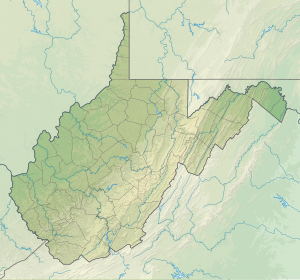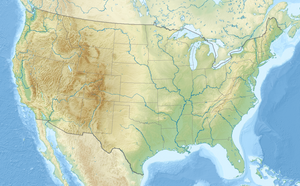Lick Run is a 2.02 mi (3.25 km) long 1st order tributary to Kings Creek in Hancock County, West Virginia.
| Lick Run Tributary to Kings Creek | |
|---|---|
| Location | |
| Country | United States |
| State | West Virginia |
| County | Hancock |
| Physical characteristics | |
| Source | North Fork Kings Creek divide |
| • location | about 3 miles northeast of Sun Valley, West Virginia |
| • coordinates | 40°27′24″N 080°31′43″W / 40.45667°N 80.52861°W[1] |
| • elevation | 1,120 ft (340 m)[2] |
| Mouth | Kings Creek |
• location | about 1 mile northeast of Weirton, West Virginia |
• coordinates | 40°25′41″N 080°32′13″W / 40.42806°N 80.53694°W[1] |
• elevation | 791 ft (241 m)[3] |
| Length | 2.02 mi (3.25 km)[4] |
| Basin size | 1.21 square miles (3.1 km2)[5] |
| Discharge | |
| • location | Kings Creek |
| • average | 1.55 cu ft/s (0.044 m3/s) at mouth with Kings Creek[5] |
| Basin features | |
| Progression | Kings Creek → Ohio River → Mississippi River → Gulf of Mexico |
| River system | Ohio River |
| Tributaries | |
| • left | unnamed tributaries |
| • right | unnamed tributaries |
| Bridges | Lick Run Road (x3), WV 1 |
Course
editLick Run rises about 3 miles northeast of Sun Valley, West Virginia, in Hancock County, West Virginia and then flows south to join Kings Creek about 1 mile northeast of Weirton.[3]
Watershed
editLick Run drains 1.37 square miles (3.5 km2) of area, receives about 39.3 in/year of precipitation, has a wetness index of 285.38, and is about 81% forested.[5]
See also
editReferences
edit- ^ a b "GNIS Detail - Lick Run". geonames.usgs.gov. US Geological Survey. Retrieved 9 June 2021.
- ^ "Get Maps". USGS Topoview. US Geological Survey. Retrieved 9 June 2021.
- ^ a b "Get Maps". USGS Topoview. US Geological Survey. Retrieved 9 June 2021.
- ^ "ArcGIS Web Application". epa.maps.arcgis.com. US EPA. Retrieved 9 June 2021.
- ^ a b c "Lick Run Watershed Report". US EPA Geoviewer. US EPA. Retrieved 9 June 2021.

